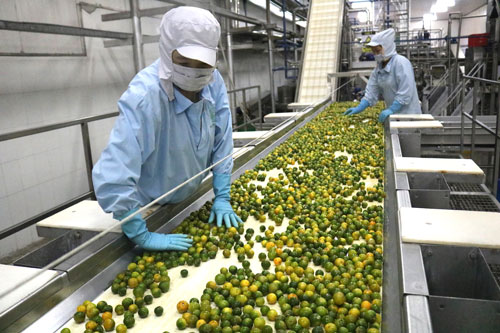DEEP PROCESSING TO INCREASE THE VALUE OF VIETNAMESE AGRICULTURAL PRODUCTS
05 Tue, 2021
The Ministry of Agriculture and Rural Development assessed that over the past time, the agricultural sector has achieved many important results but still has many limitations.

The "bottleneck" of technology
Specifically, the development process has many unsustainable factors, unstable growth, not meeting the requirements of the centralized, large-scale and high-standard commodity production from the international market. Agro-forestry-fishery processing industry, especially in deep preservation and processing, supporting industries have not yet developed strongly, post-harvest losses are still high. Linking production along the value chain to promote mechanization, application of high technology to reduce intermediate costs, and increase added value is not popular.
According to Associate Professor, Dr. Pham Anh Tuan (Institute of Agricultural Mechatronics and Post-Harvest Technology), the planning for the development of commodity agricultural production areas is not synchronized with the construction of infrastructure connecting logistics chain systems. In recent years, the number of large enterprises investing in the field of agricultural product processing has increased, but mostly focused on investment in processing technology. Meanwhile, raw materials for processing mainly depend on the method of linking with the producers or the agents, so the stability is not high and there are many potential risks. On the other hand, businesses lack investment in satellite networks to preliminarily process, classify and store raw materials for processing or packaging for domestic and export purposes - an important decisive step to stability output and increase the added value for all facilities from product production to processing and consumption.

Tien Thinh Agricultural Processing One Member Company Limited (Hau Giang) invests in machinery and technology to produce fruit juice for export
According to statistics, the number of enterprises operating in the agriculture - forestry - fishery sector is over 10,000 and most of them are small and medium enterprises, and micro enterprises. Through a survey by the Institute of Policy and Strategy for Agriculture and Rural Development, most of the technology of enterprises specializing in processing agriculture - forestry - fisheries has passed 3-4 generations, 73% of factories are temporary, patchy, only 1% -5% of products are made with international quality, 8% -15% of enterprises register product quality, 40% of enterprises have no professional qualifications and skills ...
The role of investment, technology application and innovation in the chain of production, processing and consumption of agricultural - forestry - aquatic products is indispensable for enterprises factor. However, the above statistics show that the proportion of enterprises investing in agriculture - forestry - fisheries is still very low, with outdated technology and low professional capacity. This is really the bottleneck for the agricultural industry.
Need to make use of by-products
Minister of Agriculture and Rural Development Le Minh Hoan said: "Vietnam only has about 20% -30% of agricultural products through processing for export, while in Taiwan (China) this figure is 80%. Compare to see that we need to promote processing, this is a stage that sets very high added value, creates outstanding value and distributes benefits to producers ".
According to Mr. Phan Thanh Loc, Vice Chairman of Vietnam Food Joint Stock Company, many developed countries have early realized the potential of the seafood by-products industry and successfully built products with high added value with many different applications. Mr. Loc analyzed: "Our country aims to export shrimp with a turnover of 10 billion USD by 2025, estimated output will reach over 1.1 million tons. Currently, only 55% -65% of shrimp is used. The remaining 35% -45% is often discarded, only a small portion is treated by traditional low-value methods, polluting the environment.If 400,000-500,000 tons of shrimp by-products are deeply processed, then the value is not lose to the main product ".
Mr. Nguyen Lam Vien, General Director of Vinamit Joint Stock Company, said that Vietnam has the advantage of a huge source of agricultural - forestry - fishery raw materials but does not know how to add value. Specifically, if 1 kg of sweet potato sold for fresh food is only around VND 20,000, but if processed, the value may increase dozens of times. Mr. Vien said that there are 4 ways to increase the value of agricultural products, that is: processing direction for life-changing food (eating for prevention and treatment), agricultural production towards "agricultural tourism". , organic production and deep processing technology to increase value.
Support cooperatives, small and medium enterprises
Bộ trưởng Lê Minh Hoan cho rằng HTX, DN vừa và nhỏ, DN khởi nghiệp chiếm số đông. Nếu nhà nước hỗ trợ "số đông" đó bằng nguồn vốn đầu tư, hạ tầng logistics, công nghệ bảo quản sau thu hoạch, công nghệ chế biến sẽ tạo ra sản phẩm như OCOP (chương trình Mỗi xã một sản phẩm). Và những sản phẩm do "số đông" đó làm ra được, các DN lớn tinh chế sâu hơn để xuất khẩu. Từ đó giải quyết được nguyên liệu vào mùa thu hoạch rộ cũng như việc làm cho khu vực nông thôn.
Source: https://nld.com.vn/thoi-su/che-bien-sau-de-tang-gia-tri-cho-nong-san-viet-20210502202053919.htm
Publication date: May 03,2021
Related Post
The true fishmeal carbon footprint
The established Life Cycle Analysis (LCA) methodology to assess the fishmeal carbon footprint only accounts for the vessel fuel and post-harvest processing energy while ignoring the carbon sequestration potential of fish.
View more
Freezing Tropical Fruits: Convenient and Effective Solution with Octofrost Machines
Tropical fruits are always a great choice for providing nutrition and fresh flavor to daily meals.
View more


